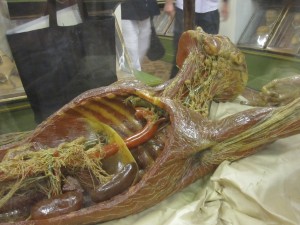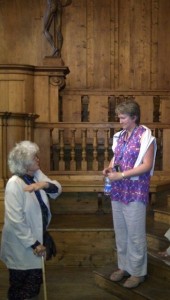 By Helen King (W&M contributor)
By Helen King (W&M contributor)
I was recently lucky enough to visit for the first time two historic anatomy theatres: the oldest permanent structure, the Padua anatomy theatre of 1594, and the 1638-39 one in Bologna. Before 1594, anatomy theatres were temporary structures, in some cases erected at the expense of the professor performing the dissection. On the tour I was leading, we went to Bologna first. I had done quite a build-up to this visit, inviting people to think about the audiences for anatomy – students? the university? the public? We know that, at some points in the history of human dissection in Bologna, posters went up in advance of a session, and tickets were sold. We also know that the spectacle was so popular that medical students were restricted in how many dissections they could attend in the course of their studies. We had thought about the origins of those dissected – normally, criminals – and I had regaled the group with the story of a man sentenced to life imprisonment who was suddenly moved on to the death sentence list because the university was short of bodies for its medical students. While I spoke to the assembled group in the anatomy theatre itself, other people drifted in and sat down to listen to me, as I tried to evoke the atmosphere of a seventeenth-century dissection, talking about the damask curtains, the candlelight and the musical accompaniment. I reminded the group that the wooden flayed men supporting the canopy over the professor’s seat were designed by Ercole Lelli, whose wonderful waxes of bodies they had seen earlier in the trip. Afterwards, the group was buzzing with excitement and looking forward to Padua.
Ah. Padua. Not such a fun experience…. Partly it was because the Palazzo del Bo, where the anatomy theatre is located, is having major repairs done. Also, we were running late, and I may have communicated my concerns about this to the group. Partly it was because this was the one visit we made for which we had to have a ‘local guide’, who did not understand that we had seen a lot of medical history already and ignored the point that we really didn’t need a list of facts of dates.
But mostly, I think, it is simply the anatomy theatre. The experience is very different. You can’t climb up to the higher tiers now, so instead you go in at ‘cadaver level’. Although the theatre can hold around 200 people, it is tiny. The shape, a inverted cone, feels very un-conelike when you are in the position of the body about to be dissected. The brilliance of the architecture and design means that the spectators are really very close indeed to the action, almost on top of it! In contrast with the later Bologna anatomy theatre, there is no decoration; no carvings of flayed men, but also no carvings of the great men of medicine, from Hippocrates and Galen onwards. At Bologna, you feel part of a great celebration of the tradition of western medicine: at Padua, you’re the body on the slab, and there are no artistic decorations to help you forget about it!

